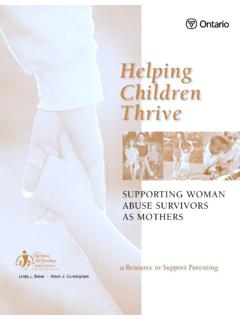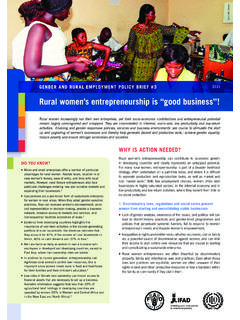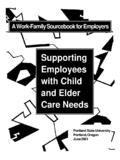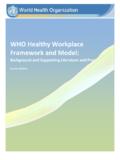Transcription of Supporting Your LGBTQ Youth: A Guide for Foster Parents
1 Child Welfare Information GatewayChildren s Bureau/ACYF/ACF/HHS1250 Maryland Avenue, SWEighth FloorWashington, DC : FOR FAMILIESMay 2013 Supporting your LGBTQ youth : A Guide for Foster ParentsUse your smartphone to access this factsheet s Inside: About LGBTQ youth LGBTQ youth and the child welfare system Creating a welcoming home for youth Supporting your youth in the community Conclusion ResourcesThere are approximately 175,000 youth ages 10 18 in Foster care in the United Of these youth , an estimated 5 10 percent and likely more are lesbian, gay, bisexual, transgender, or questioning ( LGBTQ ).21 The total number of youth in care comes from The AFCARS Report ( ). It is based on the number of youth ages 10 18 in care on September 30, The estimate comes from the assumption that 5 10 percent of the general population is LGBT.
2 John C. Gonsiorek & James D. Weinrich, The Definition and Scope of Sexual Orientation, in Homosexuality: Research Implications for Public Policy (Newbury Park, CA: Sage Publications, 1991); Courtney, Dworsky, Lee, and Raap, (2009) found a much higher percentage of youth in Foster care who identified as something other than fully heterosexual (see ). Supporting your LGBTQ youth : A Guide for Foster all young people, LGBTQ youth in Foster care need the support of a nurturing family to help them negotiate adolescence and grow into healthy adults. However, LGBTQ youth in Foster care face additional challenges. These include the losses that brought them into care in the first place, as well as traumas they may have suffered while in Foster care.
3 They also include stressors unique to LGBTQ youth , including homophobia or transphobia3 and the need to evaluate (often with little or no support) the safety of their communities, schools, social networks, and homes in order to decide whether to disclose their LGBTQ identity, when, and to whom. Despite these challenges, LGBTQ youth like all youth in the child welfare system can heal and thrive when families commit to accepting, loving, and Supporting them as they grow into their potential as adults. This factsheet was written to help families like yours understand what they need to know to provide a safe, supportive, and welcoming home for an LGBTQ youth in Foster this factsheet, you will learn about LGBTQ youth in the child welfare system, the unique risks they face, and the important role that Foster Parents can play in reducing those risks.
4 You will discover specific actions that you can take to create a welcoming home for all youth in your care and to promote your youth s health and well-being in the community. At the end of this factsheet are links to many resources for more information and Transphobia refers to fear of people who are LGBTQ YouthThe acronym LGBTQ is a general term used to describe people who are lesbian, gay, bisexual, transgender, or questioning their gender identity or sexual , gay, and bisexual describe a person s sexual orientation emotional, romantic, or sexual feelings toward other people. Lesbian refers specifically to women who love women, while gay can refer to any person who is attracted to people of the same sex. (The term homosexual is considered outdated and offensive by many gay people.)
5 Bisexual people are attracted to men or women regardless of their anatomy. People do not need to have any particular sexual experience (or any sexual experience at all) to identify as bisexual, gay, or lesbian, because sexual orientation and sexual behavior are not the same thing. Transgender refers to a person s gender identity an internal understanding of one s own gender. A transgender person s gender identity does not match the sex (a biological characteristic) assigned to him or her at birth. Many, but not all, transgender people choose to alter their bodies hormonally and/or surgically to match their gender identity. Some people s experience, perception, or expression of their gender evolves and changes over time. Gender identity and sexual orientation are separate aspects of a person s identity: A transgender person may be bisexual, gay, or straight (or may identify in some other way).
6 This material may be freely reproduced and distributed. However, when doing so, please credit Child Welfare Information Gateway. Available online at your LGBTQ youth : A Guide for Foster Parents3 This material may be freely reproduced and distributed. However, when doing so, please credit Child Welfare Information Gateway. Available online at youth (and adults) identify as questioning when they start to recognize that they may be part of the LGBT community. This does not mean that sexual orientation or gender identity is a choice. These youth may need time to process what being LGBT means for them; to reconcile any anti-LGBT stereotypes they have internalized; and to decide if, when, and how they should identify themselves as lesbian, gay, bisexual, or transgender to people s gender expression (meaning, the ways in which they express their gender identity to others) does not conform to society s expectations for their sex.
7 This might include choices in clothing, mannerisms, names, hairstyles, friends, and hobbies. It is important to understand that society s gender expectations are cultural, not biological, and they change over time (for example, women used to be expected to wear only dresses; now teens of both genders wear jeans, sweatshirts, and tennis shoes). In any case, not all gender-variant (or gender nonconforming) youth will continue to express themselves this way into adulthood, and many will never identify as gay, lesbian, bisexual, or transgender. In other words, it is best not to make assumptions. Respecting your youth s self-identification is very important. As youth grow to trust their Foster families, many will eventually share their feelings about gender identity or sexuality more openly.
8 Gaining that trust takes time, patience, and consistency. That s what [my Foster mother] gave me. LGBTQ youth in Foster careAddressing Common MisconceptionsThere is a lot of misinformation about sexual orientation and gender identity. Here are some things that are important for you to know about LGBTQ youth in your home: LGBTQ youth are a lot like other youth . In fact, the similarities that LGBTQ youth in Foster care share with other youth in care far outweigh their differences. Most, if not all, youth in Foster care have been affected by trauma and loss; they require acceptance and understanding. Making sure your home is welcoming to all differences, including race, ethnicity, disability, religion, gender, and sexual orientation, will help ensure that all youth in your home feel safe and that the youth in your care grow into adults who embrace diversity in all of its is not just a phase.
9 LGBTQ people are coming out (acknowledging their sexual orientation/gender identity to themselves and others) at younger and younger ages. Studies by the Family Acceptance Project have found that most people report being attracted to another person around age 10 and identifying as lesbian, gay, or bisexual (on average) at age 13. Gender identity may begin to form as early as ages 2 to Someone who has reached the point of telling a Foster parent that he or she is LGBTQ has likely given a great deal of thought to his or her own identity and the decision to share one caused your youth s LGBTQ identity. Sexual orientation and gender 4 Ryan, C. (2009). Helping families support their lesbian, gay, bisexual, and transgender (LGBT) children.
10 Washington, DC: National Center for Cultural Competence, Georgetown University Center for Child and Human your LGBTQ youth : A Guide for Foster material may be freely reproduced and distributed. However, when doing so, please credit Child Welfare Information Gateway. Available online at are the result of complex genetic, biological, and environmental factors. your youth s LGBTQ identity is not the result of anything you (or a birth parent, or any other person) did. LGBTQ people come from families of all religious, political, ethnic, and economic backgrounds. Experiencing childhood trauma or reading about, hearing about, or being friends with other LGBTQ people did not make the youth become youth are no more likely than other youth to be mentally ill or dangerous.
















